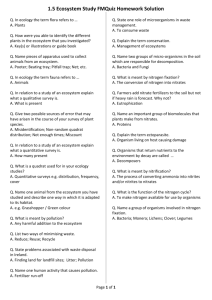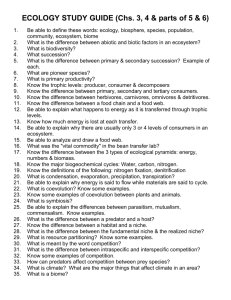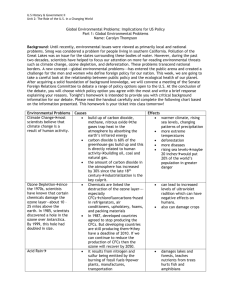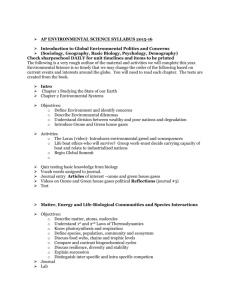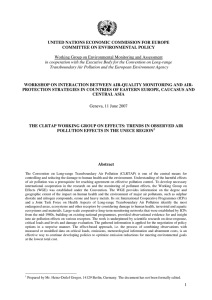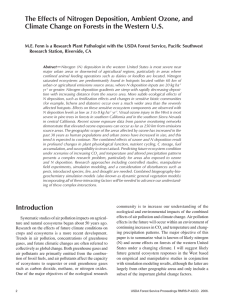AP Environmental Science Exam Review
advertisement
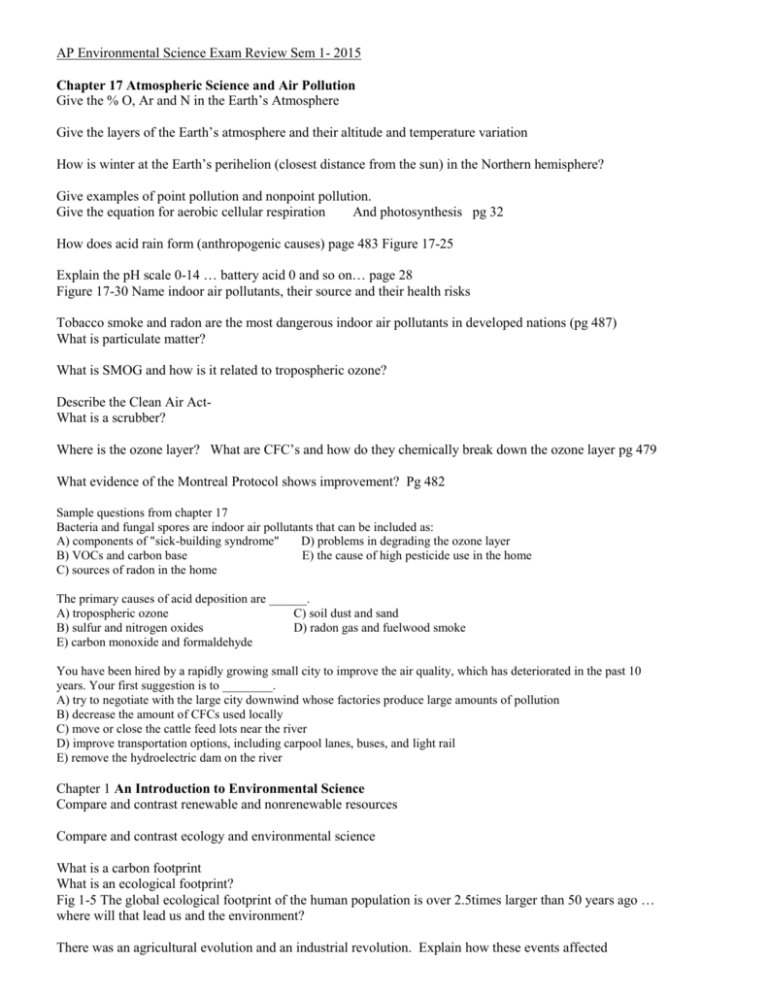
AP Environmental Science Exam Review Sem 1- 2015 Chapter 17 Atmospheric Science and Air Pollution Give the % O, Ar and N in the Earth’s Atmosphere Give the layers of the Earth’s atmosphere and their altitude and temperature variation How is winter at the Earth’s perihelion (closest distance from the sun) in the Northern hemisphere? Give examples of point pollution and nonpoint pollution. Give the equation for aerobic cellular respiration And photosynthesis pg 32 How does acid rain form (anthropogenic causes) page 483 Figure 17-25 Explain the pH scale 0-14 … battery acid 0 and so on… page 28 Figure 17-30 Name indoor air pollutants, their source and their health risks Tobacco smoke and radon are the most dangerous indoor air pollutants in developed nations (pg 487) What is particulate matter? What is SMOG and how is it related to tropospheric ozone? Describe the Clean Air ActWhat is a scrubber? Where is the ozone layer? What are CFC’s and how do they chemically break down the ozone layer pg 479 What evidence of the Montreal Protocol shows improvement? Pg 482 Sample questions from chapter 17 Bacteria and fungal spores are indoor air pollutants that can be included as: A) components of "sick-building syndrome" D) problems in degrading the ozone layer B) VOCs and carbon base E) the cause of high pesticide use in the home C) sources of radon in the home The primary causes of acid deposition are ______. A) tropospheric ozone C) soil dust and sand B) sulfur and nitrogen oxides D) radon gas and fuelwood smoke E) carbon monoxide and formaldehyde You have been hired by a rapidly growing small city to improve the air quality, which has deteriorated in the past 10 years. Your first suggestion is to ________. A) try to negotiate with the large city downwind whose factories produce large amounts of pollution B) decrease the amount of CFCs used locally C) move or close the cattle feed lots near the river D) improve transportation options, including carpool lanes, buses, and light rail E) remove the hydroelectric dam on the river Chapter 1 An Introduction to Environmental Science Compare and contrast renewable and nonrenewable resources Compare and contrast ecology and environmental science What is a carbon footprint What is an ecological footprint? Fig 1-5 The global ecological footprint of the human population is over 2.5times larger than 50 years ago … where will that lead us and the environment? There was an agricultural evolution and an industrial revolution. Explain how these events affected humans. Hey, remember the steps of the Scientific Method and what each step entails? Page 11 What are the dependent and independent variables, the control and the hypothesis? Explain the types of graphs and the correlation between variables. What is sustainability? ( the chapter uses a term sustainable development) Essay Question: If the human population were to stabilize tomorrow and never surpass 7 billion people, would that solve our environmental problems? What types of problems might be alleviated and which might worsen??? Chapter 2 Earth’s Physical Systems, Matter, Energy and Geology Table 2-1 Know Earth’s most abundant chemicals in the: crust air ocean and organisms Law of Conservation of Energy Law of Conservation of Matter Chemistry- write the formula for these important compounds carbon dioxide, methane, ozone, salt, hydrochloric acid, hydrosulfuric acid, glucose Properties of water: cohesion and adhesion First Law of Thermodynamics Second Law of Thermodynamics (entropy) Autotrophs /primary producers using light Cellular respiration releases chemical energy is what fraction of the energy input per glucose molecule( Which Law of Thermodynamics) Heterotrophs function in cellular respiration and photosynthesis What is chemosynthesis? Consider the following processes: respiration, chemosynthesis, combustion, fermentation, polymerization and photosynthesis. How many of these result in the release of oxygen into the atmosphere? A) none B) 1 C) 2 D) 4 E) all Plate boundaries and geologic events: geothermal energy, volcanism convergent boundary, underwater volcanoes divergent boundaries, earthquakes at transsform boundary, hot spots (the Hawaii intraplate), geysers Page 35 Pacific Ring of Fire Rock Cycle page 37 Know which type of rock most fossils are formed form. Page 41, what have models helped engineers with when designing building tht are on earthquake fault boundaries? Pg 43 Marginal land is unstable and more prone to L___________ Essay Question: What layer of the Earth consists of the oceanic and continental crust? Explain how they are different and tell geologic feature their boundaries form during plate tectonics. The force causing water molecules to adhere to one another in interactions is called: A) Van der Waals attractions B) polar covalent bonds C) nonpolar covalent bonds D) hydrogen bonds Precipitation ________. A) that is acidic has a low concentration of hydrogen ions B) that is acidic would have a pH+ higher than 7 C) that is acidic would have a pH+ lower than pure water D) that measures pH+ = 4 is twice as acidic as precipitation that measures pH+ = 5 E) has become increasing more basic in the last 100 years, due to industrial air pollution The San Andreas Fault in California is an example of which type of boundary:___________ Synthetic polymers are plastics that: A. biodegrade well B. form Nylon and fiber optics C. are only safe in aquatic ecosystems Chapter 3 Evolution, Biodiversity and Population Ecology Organism to species to population to community to ecosystem Be sure you can understand why this flows in this direction. Where are the biotic and abiotic factors on your “species pyramid”? What was your species? How do you correctly name a species? Genus species How is natural selection a part of evolution? Read Table 3-1 page 53 How is natural selection an adaptation? What is a positive mutation? What is a negative mutation? Biological Diversity = Allopatric speciation example How old is Earth ___________and when was the first life form (fossil evidence)? What is the equation for population growth rate? What are the conditions of exponential growth rate and what are some populations that have this rate? What are some limiting factors and how do they involve the carrying capacity? What are some factors that have changed the carrying capacity of humans? Pg 70 The capacity to reproduce: k-selected and r- selected. Explain and give examples of each. Density dependent and density independent Ch 4 Species interactions and Community Ecology Table 4-1 Interactions among species KNOW THEM ALL AND AN EXAMPLE OF EACH I will use a lot of the book examples What ate trophic levels and how do you rate the energy (primary producers, prim. comsumer, sec comsumer, and tertiary consumer Producers, consumers, autotrophs, heterothrophs, apex predator Food chains intertwine into ________________ Keystone speciesInvasive species Resistance vs. resiliance What is the effect of zero ecological restoration? Biomes, biomes, biomes… C_____________ and P_______________. Page 98 to 102 look at the pictures and subheadings for each biome. How is altitude like latitude? Ch 5 -Environmental Systems and Ecosystem Ecology Give an example of a system: How does a system show a negative feedback loop? What are emergent properties again??? geosphere, hydrosphere, lithosphere atmosphere and biosphere How is an ecosystem different from these structural spheres? Explain how energy is converted into biomass (high net primary productivity). GIS, ecosystem services and ecological modeling… know them all and how and why we use them. Cycles: water page 123 (transpiration) Carbon page 125 fossils in sedimentary rock form fossil fuels) Nitrogen page 129 (nitrogen fixing bacteria convert atmospheric nitrogen into nitrogen the plants can absorb) Specify pools of nitrogen Phosphorus cycle page 131 know it! Read the reviewing section page 133 Artificial and natural eutrophication Ch 6 Environmental Ethics and Economic Study your notes page 163 Reviewing Objectives (plus one question on neoclassical economics) Ch 7 Environmental Policy and Decision Making Page 192 –193 reviewing Objectives (plus know what CDC OSHA FDA do) Go to my website an review the Jeopardy game!!! That’s a great review of the three waves, industrial revolution, Acronyms, and vocabulary Ch 8 Human Population Test Your Comprehension 1-10 What number in this series should show a growth in plankton population? Harmful Algal Bloom and Hypoxia Research and Control Act both in 1998 and 2004. Page 177 and more……. Describe the Clean Air Act Describe the Safe Drinking Water Act Describe the Clean Water Act Describe the Endangered Species Act Describe Superfund Act DescribeWilderness Act Describe Lacey Act Google it!!! Describe CITES (treaty)
